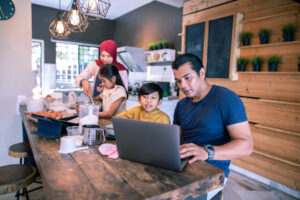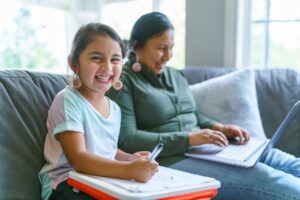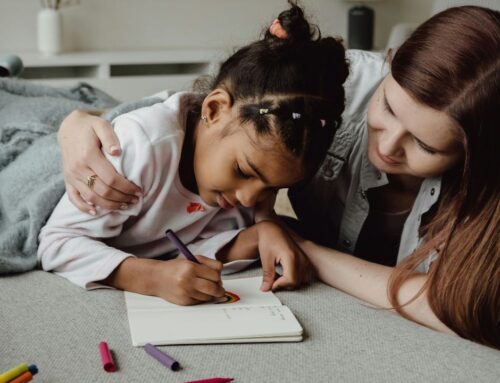The home learning lifestyle is definitely an adjustment. Some home learning days whizz by, loaded with laughter, curiosity and enthusiasm. Others can feel more challenging, especially if the parent/guardian is stretched thin. It takes time to find your rhythm. But along the way, there are simple and meaningful ways you can pause, recharge and care for yourself while supporting your child’s learning journey.
Tailor your daily routines for flexibility and nourishing breaks

One of the greatest perks of home learning is that you and your family get to decide how your days unfold. You can design a daily rhythm that allows space for rest, connection and calm—for you and your child.
SelfDesign’s interim president, CEO and home learning parent, Nikki Kenyon, shares how slow mornings supported her family’s nervous system when they were young.
“When I would wake my children up in the morning, it would be a gentle, slow, connected engagement,” shares Nikki. “They would come and cuddle with me on the couch for 20 minutes. Sometimes we’d read a book before we did anything else. I was careful to schedule things so that we didn’t start any planned activities before 10 a.m. so that we could have those slow starts.”
SelfDesign parent Cheryl Woodhouse, who has three children in the program, describes how a flexible routine supports her family’s well-being:
“I get to follow my body clock (circadian rhythm) and my children’s body clocks,” Cheryl says. “We don’t have a rigid schedule, and this means that our kids get to listen to their bodies more. They don’t have to wake up at the crack of dawn, rush out the door and stress their adrenals, which has meant a lot more peace and calm in our house.”
Save time and energy by incorporating learning into everyday chores and tasks

You don’t need to separate learning from daily tasks. Incorporating learning into everyday life helps prevent burnout by saving time and energy—and it’s incredibly enriching for your child.
Nikki honours the SelfDesign philosophy that all learning is interconnected. For example, preparing a meal with her children can cover a wide range of subjects:
-
- Planning a menu = critical thinking and creativity
- Writing a shopping list = literacy
- Budgeting and shopping = math and real-world problem-solving
- Cooking = science, measurements and motor skills
- Writing a recipe review = reflection and communication
Nourish your body and mind by going outside often
Nothing beats fresh air and sunshine when it comes to your energy levels and mental health. Incorporate lots of outdoor time into your family’s daily schedule with sports, plant and animal identification, and learning about ecology, biology, weather, astronomy, geology and geography.
Fresh air, movement, and unstructured outdoor time are powerful tools for maintaining energy and emotional well-being. To get some real outside downtime, encourage your children to practice slow, deep observation and listening, and have older learners journal about it afterward.
Try incorporating these outdoor learning activities into your week:
-
- Nature walks with plant and animal ID
- Journaling after quiet outdoor observation
- Outdoor sports and movement breaks
- Lessons in ecology, biology, weather or astronomy
Encourage slow, mindful time in nature. Both you and your child reap the benefits—and you get a chance to pause and reset.
Build webs of support with like-minded parents
Parenting—especially home learning—was never meant to be done alone. Sometimes, life gets so busy that it’s easy to forget to connect with other adults. The human brain is wired for connection. Connecting with other parents helps reduce stress, regulate emotions and remind you that you’re not alone in this journey.
Arranging playdates for your learners achieves two major things: your learner gets much-needed in-person peer interaction, and you get a bit of a break. This is especially important for parents with young children who require more attention.
Different ways you can take time for yourself
It is not selfish to prioritize your own needs alongside the needs of your child. In fact, the more resourced you are, the better you can show up for home learning. It’s all about maintaining equilibrium! Don’t hesitate to make choices that support your well-being:
-
- Schedule personal time. Perhaps this means sharing home learning duties with other families for one afternoon per week or putting on an educational documentary for your children so you can take an hour or two.
- Utilize SelfDesign’s online learning resources to facilitate independent learning when you need a break.
- Practice self-care and prioritize sleep! Get comfortable asking for support
Support for parents/guardians is out there—but it’s up to you to reach out. If your child is in SelfDesign, talk to your learning consultant whenever you need guidance or encouragement.
You could also find some local community classes for your child. Recreational and youth centres are great places for your child to learn sports, art techniques, dance and more. You can use this time to run errands or take care of other details. The bonus is in-person connections for your child!
There are also support groups for home learning parents. Sometimes, it’s comforting to listen to other parents’ stories and connect with people who may encounter similar home learning challenges. These groups are often where long-lasting friendships are born.
Parent burnout is real (and optional)
Continually remind yourself why you and your family have chosen the home-learning path. Often, we lose sight of the bigger picture, and it can be encouraging to take note of positive changes your child is experiencing on their learning journey.
Celebrate the small wins, set realistic learning goals and most importantly—practice self-compassion. When you practice self-compassion and patience, you model these qualities to your children. The process may feel daunting at times, and it’s normal for challenges to arise.
Remind yourself that all good things take time and patience, and as the years go on, your family’s home learning process will eventually run like a well-oiled (and well-rested) machine.
Learn more about what it’s like to be a home-learning parent at SelfDesign here.







